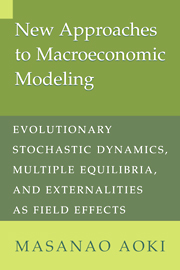 New Approaches to Macroeconomic Modeling
New Approaches to Macroeconomic Modeling Book contents
- Frontmatter
- Contents
- Preface
- Part I Introduction
- Part II Modeling Interactions
- 4 Modeling interactions I: Jump Markov processes
- 5 Modeling interactions II: Master equations and field effects
- 6 Modeling Interactions III: Pairwise and Multiple-Pair Interactions
- Part III Hierarchical Dynamics and Critical Phenomena
- Appendix
- References
- Index
5 - Modeling interactions II: Master equations and field effects
Published online by Cambridge University Press: 05 May 2010
- Frontmatter
- Contents
- Preface
- Part I Introduction
- Part II Modeling Interactions
- 4 Modeling interactions I: Jump Markov processes
- 5 Modeling interactions II: Master equations and field effects
- 6 Modeling Interactions III: Pairwise and Multiple-Pair Interactions
- Part III Hierarchical Dynamics and Critical Phenomena
- Appendix
- References
- Index
Summary
In Chapter 4, we introduced jump Markov processes to pave our way for modeling a large collection of interacting agents. We concentrate here on the types of interactions or externalities that do not lend themselves to modeling with pairwise interaction. We call these externalities “field effects.” This term is chosen to convey the notion that interaction with a whole population or class of microeconomic units is involved, that is, aggregate (macroeconomic) effects are due to contributions from a whole population of microeconomic units, or, composition of the whole in the sense that fractions of units in various states or categories are involved. We defer until Chapter 6 our discussion of pairwise interaction or interactions with randomly matched (drawn) anonymous microeconomic units.
A good way to examine field effects – that is, stochastic and dynamic externality – is to study the dynamic behavior of a group of agents who interact through the choices they make in circumstances in which each agent has a set of finite decisions to choose from, and in which they may change their minds as time progresses, possibly at some cost. In such situations, an agent's choice is influenced by the vector of the fractions of agents who have selected the same decisions, because his or her perceived profit or benefit from a decision change will be a function of this vector, namely, the composition of agents with the same decisions in the whole population of agents.
- Type
- Chapter
- Information
- New Approaches to Macroeconomic ModelingEvolutionary Stochastic Dynamics, Multiple Equilibria, and Externalities as Field Effects, pp. 113 - 170Publisher: Cambridge University PressPrint publication year: 1996


